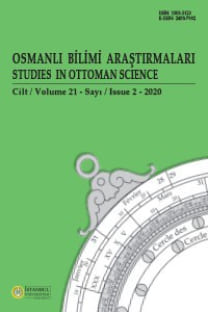Osmanlı donanma gemilerinin ilaç sandıkları: Ondokuzucu yüzyıl başına ait bir araştırma
Çeşitli iklimlerde ve açık denizde uzun süreli yolculuklar ve hastalıkların bu yolculuklardaki yıkıcı etkisi, ilaç sandığının ticari veya donanma gemilerinde kullanılmasını zorunlu kılmıştır. Bunların kullanımı onyedinci yüzyıl Avrupasında artık yaygınlaşmış, hazırlanmasıyla ilgili yönetmelikler çıkarılmıştı. Ondokuzuncu yüzyılın başında, tifo, kolera, dizanteri, tropik hastalıklar, iskorbit, verem, frengi, gemi kaptanlarının en korkutan hastalıklardandı. Yaralanmalar, kanamalar, fıtık, seferler sırasında en sık rastlanılan cerrahi sorunlardı. Arşiv belgeleri, Osmanlı gemilerinde onaltıncı yüzyıldan beri cerrahın görevli olduğuna işaret etmektedir. Gemilere ilaç ve cerrahi malzeme içeren sandıkların ilk defa ne zaman alındığını bilemiyorsak da, gemi cerrahının, sefer boyunca ihtiyaç duyacağı ilaç ve malzemeyi yanında bulundurduğuna şüphe yoktur. Onaltıncı yüzyılda gemi cerrahlarının ilaç ve malzemeyi kendilerinin temin etmesi istenirdi. Onsekizinci yüzyılda bu görevin İstanbul’daki bazı hekimlere verildiği anlaşılmaktadır. Nihayet ondokuzuncu yüzyılda, gemilere verilen ilaç sandıklarının eczacılar tarafından hazırlanmış olduğunu görmekteyiz. Bu bildiri, Karadeniz’e ve Akdeniz’e sefere çıkacak olan Osmanlı gemilerine 1830 ve 1831 yıllarında verilmiş olan hekim ve cerrah sandıklarının içeriğini tanıtmaktadır. Sandıkların içeriğini belgeleyen listelerde, tiryaklar, merhemler, yakılar, tozlar, yağlar, haplar gibi farmasötik formları; kusturucular, sürücüler, ağrı kesici ve sakinleştiriciler, kuvvet verici ve ateş düşürücüler yanında hem tedavide hem de cerrahide kullanılacak bir dizi drogu içermektedir. Bu droglar ve formlar, onsekizinci ve ondokuzuncu yüzyıl Avrupa gemilerinde kullanılanlar ile karşılaştırıldığında, dikkat çekici bir benzerlik görülür. Bununla birlikte, Osmanlı gemilerinde kullanılan ilaç çeşidi sayısı, Avrupa gemilerindekilerden daha düşük sayıdadır.
Anahtar Kelimeler:
Hekim sandığı, cerrah sandığı, ilaç sandığı, Osmanlı donanması, deniz eczacılığı.
Medicine chests of the Ottoman navy: Notes for the early nineteenth century
Long distance navigation through various climates and the debilitating effects of diseases in sea voyages or marine expeditions made the medicine chests compulsory for merchant ships and the navy. The use of medicine chests at sea was already well established in the 17th century Europe. Regulations were issued and pharmacists were authorized in preparing them. At the turn of the 19th century, typhoid fever, cholera, dysentery or other tropical diseases as well as scurvy, tuberculosis and syphilis were among the most troubling diseases for ship captains and owners. Injuries and hemorrhages, and hernia were among the most frequent surgical problems encountered during the expeditions. Archival documents attest to the presence of surgeons on board of Ottoman vessles as early as 16th century. Although it is not clear when exactly medical chests became part of the Ottoman ship load, on might assume that galley-surgeons (cerrah-i kalyon) had drugs and surgical equipment at their disposition during the expedition. The 16th century surgeons were asked to supply the necessary drugs before embarking on the ship. In the 18th century, this task was given to physicians settled in Istanbul. Finally in the 19th century, apothecaries (eczacı, ispençiyar) were endowed with the job. The present paper will examine the lists of medicines and material that were introduced into the physicians’ chests (hekim sandı ğı, tabib sandı ğı) and the surgeons’ chests (cerrah sandı ğı) supplied for the Ottoman vessels sailing off for the Mediterranean and the Black Sea. Dated 1830 and 1831, these lists included pharmaceutical forms among them theriacs, ointments, cataplasmes, powders, syrups, essential oils and pills. On board, emetics (Ipecacuanha), purgatives (Epsom salts, jalap), and analgesics (laudanum, theriac, camphor), tonics (cinchona bark and powder), mercury salts and a diversity of other drugs were used as therapeutics and for surgical operations. A comparison of these drugs with those used in late 18th century European vessels shows a striking similarity. Nevertheless the variety of the drugs were less than that of European ships heading for high sea.
Keywords:
medicine chest, medical chest, surgeon chest; Ottoman navy, naval pharmacy,
___
- -
- ISSN: 1303-3123
- Yayın Aralığı: Yılda 2 Sayı
- Başlangıç: 1995
- Yayıncı: İstanbul Üniversitesi Edebiyat Fakültesi
Sayıdaki Diğer Makaleler
ASUMAN BAYTOP’UN ÖZGEÇMİŞİ, BOTANİK GEZİLERİ, BİTKİ KOLEKSİYONU, KİTAPLARI, YAYIN LİSTESİ
Mekteb-i Tıbbiye-i Şahane’nin 1870’li yılların başındaki doğa tarihi koleksiyonu
Osmanlı İmparatorluğu’nda Afyonun Tarihi
Şehremini Merkez Eczanesi’nin Reçete Kayıt Defteri
Türkiye’de Diş Hekimliği Eğitim ve Öğretimi (1908-1933)
Ali BALTACIOĞLU, İsmail BALTACIOĞLU
Osmanlı’nın ilk jeoloji kitabı ve Osmanlı’da jeolojinin durumu hakkında öğrettikleri
Türkiye bitkileriyle ilgili bazı gelenekler, törenler ve inançlar
Bunsen beki ve spektral analizin doğuşu ve Türkiye’de tanıtılması
Osmanlı eczacılığında bir kilometre taşı: İngiliz Eczanesi, İstanbul
